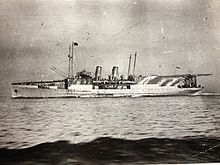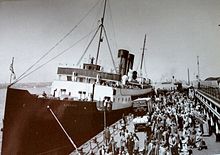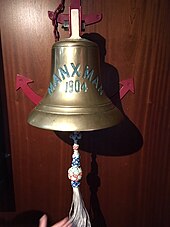TSS Manxman (1904)
TSS Manxman was a turbine steamship launched in 1904 for the Midland Railway and operated between Heysham and Douglas, Isle of Man.
In 1916, she was commissioned by the Royal Navy as HMS Manxman and saw action as a seaplane carrier during the First World War, after which she was acquired by the Isle of Man Steam Packet Company.
However, industry as a whole was in a disorganised and seriously run-down state after the challenges of the war years, and new ships could not possibly be built in time for the tourist influx of 1919.
The Isle of Man Steam Packet Company bought Manxman from the Admiralty in March 1920, and she was the first ship in the line's history to be so named.
Upon her purchase, being the largest steamship in the fleet, Manxman became the Commodore Ship under Captain Cain, a position she retained until the introduction into service of the Ben-my-Chree in 1927.
No sooner had she returned from her final journey to Dunkirk, she was ordered west to Dartmouth, where she had the ironical experience of being fired on by a small guard boat that had obviously not been alerted to her arrival.
The evacuation of the ports of north-west France was beginning, and Manxman's crew knew the coast well, having spent some months before Dunkirk carrying troops to Le Havre and Cherbourg.
As the days advanced the shelling came nearer, the raids more frequent, and the Cherbourg harbour area necessarily more congested with survival boats, wrecks and the debris of battle.
The Manxman herself was laden with troops and with stacked ammunition, small arms and even field weapons saved from the catastrophe – one hit from an enemy aircraft could have blown up the entire ship.
The Manxman then pulled out, thanks to fire cover from a Royal Navy destroyer, which had turned her forward guns on to the German tank column as it advanced down the quayside.
[6] The Manxman's main duties were at Cherbourg, but she was also deeply involved at the small port of St Malo, to the east, where she was the last ship to leave the shattered harbour.
From Douglas she spent some time on patrol in the Irish Sea, while naval personnel were initiated into the workings of radio direction finding.
Caduceus made passage to the River Clyde and continued her radar training duties, only to be driven ashore near Greenock in a fierce gale in February 1943.
She acted as a troop carrier and eventually moved to the traffic between Harwich and Tilbury and the Belgian and Dutch ports, bringing over service personnel, civilians and displaced persons.
She was never to return home to Manx waters, and after a somewhat punishing but nonetheless adventurous life, she was withdrawn in February 1949, no longer fit for use, and was subsequently laid up at Barrow-in-Furness.
In his attempt to return the hat, Formby falls into the water and people on board the ship throw life buoys to him with "SS Manxman" clearly visible.



